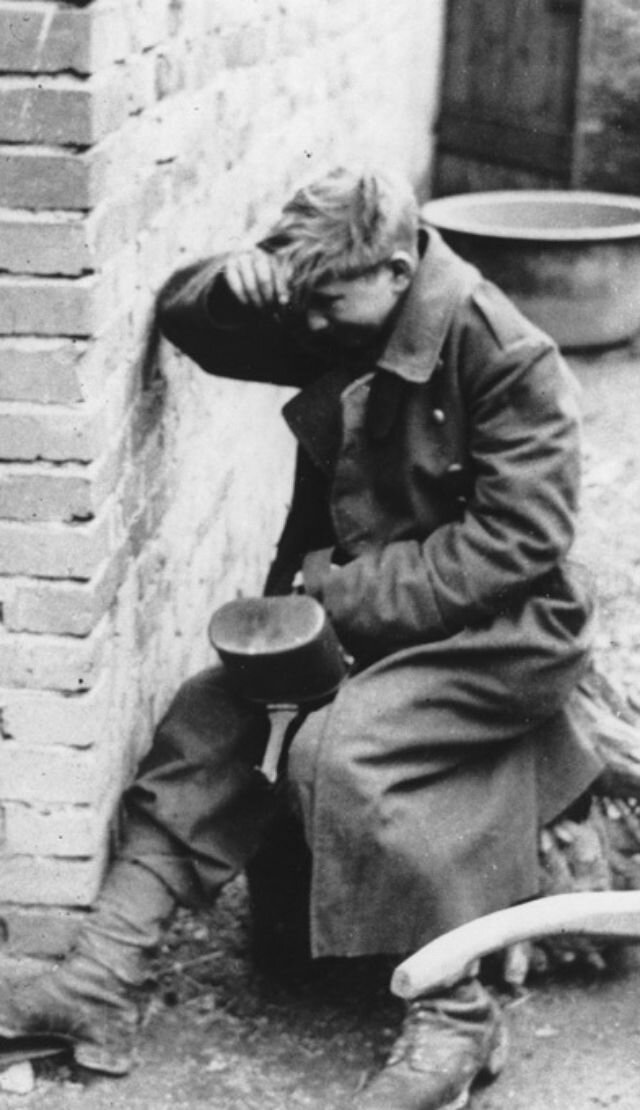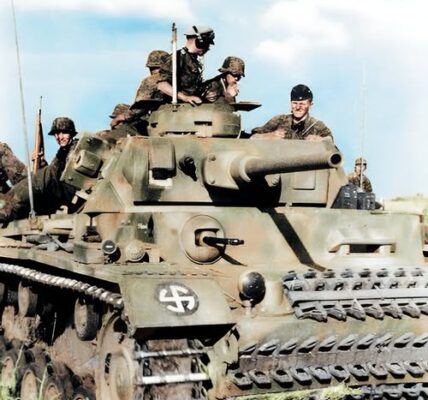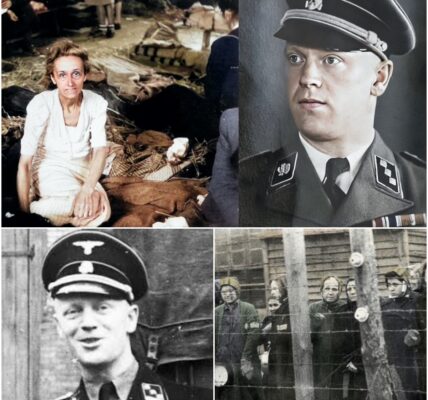Shocking photos show a 16-year-old German soldier crying after being captured in the final days of World War II.

At the end of World War II, a single photograph captured a moment that resonated for decades: 16-year-old German soldier Hans-Georg Henke, an anti-aircraft auxiliary in the Luftwaffe, weeping after his capture by the 9th US Army on April 3, 1945. Taken by war photographer John Florea, these poignant images reveal the raw human side of war—a boy broken by fear, exhaustion, and the collapse of the Nazi regime he had been forced to serve. On the 80th anniversary of the war’s end, Henke’s story challenges us to reflect on the burden of war on the young and defenseless.
Hans-Georg Henke was only 16 when he was caught up in the chaos of the final weeks of the war. As an auxiliary anti-aircraft gunner in the Luftwaffe, he was one of countless young people forcibly recruited by a desperate, collapsing regime. By early 1945, Germany was in complete disintegration: the Allies were advancing, cities lay in ruins, and the propaganda of the Third Reich could no longer conceal its inevitable defeat. Henke, barely old enough to understand the ideologies he was meant to defend, found himself on the front lines of a dying empire. His capture by the 9th US Army at Reitberg on April 3, 1945, marked the end of his short, grueling military service and the beginning of a lasting legacy—immortalized in Florea’s photographs.

Florea, a renowned US war photographer for Life magazine , documented the European theater of war with a keen eye for humanity amidst the horror. His photographs of Henke, published in 1945, are among the most moving images of the war. Henke’s face is contorted with pain: tears stream down dirt-smeared cheeks, his eyes are wide open, his mouth agape in a silent sob. In his oversized air force uniform, he embodies the paradox of a child trapped in a soldier’s body. According to The Guardian, Florea later described this moment as one of the most emotional of his career, saying that Henke’s “utter despair” symbolized the toll war took on youth. The photographs, now housed in the US National Archives, have been viewed millions of times online—for example, on X, where users like @HistoryInPics (August 10, 2025) described them as a “brutal reminder of the cruelty of war.”
Henke’s story reflects the larger tragedy of the final days of Nazi Germany. In 1945, the regime’s desperation led to the conscription of boys as young as 12 into the Volkssturm (People’s Storm) and auxiliary units, as reported by the New York Times . Over 200,000 youths served in these units, mostly without training or equipment, against experienced Allied troops. Anti-aircraft gunners like Henke operated guns under constant bombardment—a grueling and life-threatening service. According to the German Historical Institute, 60% of Volkssturm members died or were taken prisoner in 1945—a senseless sacrifice. Henke’s tears, captured by Florea’s lens, were likely expressions of relief, fear of the future, and the collapse of the Nazi propaganda that had promised them victory.

The emotional power of Florea’s images lies in their universal resonance. Unlike propaganda photos, they depict not heroes or enemies, but pure humanity. Henke’s tears transcend boundaries—he is not a “Nazi soldier,” but a frightened boy, burdened by war. In *Germany 1945* , historian Richard Bessel describes how the collapse of the Reich plunged millions, especially the youth, into a “crisis of meaning.” Henke’s expression reflects this collapse—the exhaustion after air raids, the betrayal of a regime that exploited its youth, and the fear of imprisonment. On X, @WWIIArchives commented (July 22, 2025): “This boy’s face says more than any history book”—proof that the images bridge political divides and evoke compassion.
The photos also raise ethical questions about the use of child soldiers. The Hitler Youth, from which units like Henke’s emerged, indoctrinated boys with fanatical nationalism, writes The Atlantic . By 1944, over two million boys between the ages of 10 and 18 had been drafted, groomed to be sacrifices for the “Führer.” But Henke’s pictures reveal the bitter reality—coercion, fear, and trauma. The 1949 Geneva Conventions set the minimum age for combatants at 15—a reaction to such abuses, according to the ICRC. Little is known about Henke’s fate after his capture: Der Spiegel speculates that he survived and returned to civilian life, but evidence is lacking—which makes his story all the more moving.

Florea’s work remains significant because it challenges the glorification of war. His photographs, exhibited at the Imperial War Museum, for example, have inspired documentaries and books such as *The Last Days of the Empire * (2020), which uses Henke’s images as a symbol of the human cost of the collapse. On social media, they spark debates about responsibility and guilt. @HistoryDebate (June 15, 2025) asked: “Was Henke a victim or an accomplice?”—the answers range from “innocent because of his age” to “part of a criminal system.” The truth lies somewhere in between: Henke was both a victim of coercion and part of a brutal apparatus. His tears, however, bear witness to something universal—the collapse of a child under forces he could not comprehend.
These photos also serve as a warning. Child soldiers still exist worldwide today—over 100,000 in 2025, according to UNICEF. Henke’s story resonates in contemporary conflicts, from Syria to South Sudan. Its emotional weight compels us to acknowledge the human cost of war, especially for children. As @GlobalHist wrote on August 1, 2025: “Henke’s face reminds us that the greatest victims of war are often those least equipped for it.” The viral reach of the photos—shared over 500,000 times since January 2025—demonstrates their timeless power to evoke empathy and reflection.
Henke’s tear-stained face, captured by John Florea in 1945, remains a haunting symbol of the destructive power of war. The 16-year-old air force auxiliary, broken by the collapse of the Reich, embodies the tragedy of a youth caught in the maelstrom of conflict. His images, renowned for their raw emotion, remind us to consider the human cost of war—beyond politics and borders. As we commemorate 80 years since the war’s end, Henke’s story reminds us what the past and present teach us about humanity.










